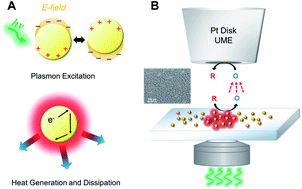当前位置:
X-MOL 学术
›
Faraday Discuss.
›
论文详情
Our official English website, www.x-mol.net, welcomes your
feedback! (Note: you will need to create a separate account there.)
Quantifying photothermal heating at plasmonic nanoparticles by scanning electrochemical microscopy
Faraday Discussions ( IF 3.3 ) Pub Date : 2018-03-12 , DOI: 10.1039/c8fd00057c Yun Yu 1, 2, 3, 4 , Jeffrey D. Williams 1, 2, 3, 4 , Katherine A. Willets 1, 2, 3, 4
Faraday Discussions ( IF 3.3 ) Pub Date : 2018-03-12 , DOI: 10.1039/c8fd00057c Yun Yu 1, 2, 3, 4 , Jeffrey D. Williams 1, 2, 3, 4 , Katherine A. Willets 1, 2, 3, 4
Affiliation

|
Photothermal heating at metal nanoparticles results from the non-radiative decay of localized surface plasmons. The local heat generation enhances the mass transport rate of redox molecules and causes a shift in their formal potential, both of which can impact an electrochemical process at the nanoparticle interface. Here we present a methodology for probing the surface temperature at a plasmonic nanoparticle substrate using scanning electrochemical microscopy (SECM). Light is used to excite a plasmonic substrate electrode, while an ultramicroelectrode tip is positioned close to the substrate to read out both the mass transfer rate and concentration profile of the redox molecules. The measured mass transfer rate and the shift in the equilibrium potential provide a quantitative value of the temperature increase at the substrate surface, which is verified by simulations using a mass transfer model coupled with heat dissipation. The developed SECM approach is suitable for probing heat generation at a variety of both plasmonic and non-plasmonic nanostructures.
中文翻译:

通过扫描电化学显微镜量化等离激元纳米粒子的光热加热
金属纳米粒子的光热加热是由于局部表面等离子体激元的非辐射衰减所致。局部生热提高了氧化还原分子的质量传输速率,并导致其形式电位发生变化,这两者都会影响纳米粒子界面上的电化学过程。在这里,我们介绍了使用扫描电化学显微镜(SECM)探测等离子体纳米颗粒基质表面温度的方法。光用于激发等离激元基体电极,而超微电极头位于基体附近,以读取氧化还原分子的传质速率和浓度分布。测得的传质速率和平衡电位的变化提供了基材表面温度升高的定量值,通过使用传质模型和散热的仿真验证了这一点。发达的SECM方法适用于探测各种等离子和非等离子纳米结构的热量产生。
更新日期:2018-10-10
中文翻译:

通过扫描电化学显微镜量化等离激元纳米粒子的光热加热
金属纳米粒子的光热加热是由于局部表面等离子体激元的非辐射衰减所致。局部生热提高了氧化还原分子的质量传输速率,并导致其形式电位发生变化,这两者都会影响纳米粒子界面上的电化学过程。在这里,我们介绍了使用扫描电化学显微镜(SECM)探测等离子体纳米颗粒基质表面温度的方法。光用于激发等离激元基体电极,而超微电极头位于基体附近,以读取氧化还原分子的传质速率和浓度分布。测得的传质速率和平衡电位的变化提供了基材表面温度升高的定量值,通过使用传质模型和散热的仿真验证了这一点。发达的SECM方法适用于探测各种等离子和非等离子纳米结构的热量产生。











































 京公网安备 11010802027423号
京公网安备 11010802027423号